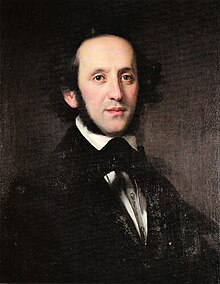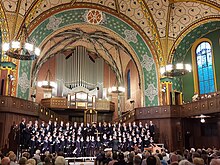
Missa brevis usually refers to a mass composition that is short because part of the text of the Mass ordinary that is usually set to music in a full mass is left out, or because its execution time is relatively short.

The Thomanerchor is a boys' choir in Leipzig, Germany. The choir was founded in 1212. The choir comprises about 90 boys from 9 to 18 years of age. The members, called Thomaner, reside in a boarding school, the Thomasalumnat and attend the St. Thomas School, Leipzig, a Gymnasium school with a linguistic profile and a focus on musical education. The younger members attend the primary school Grundschule Forum Thomanum or Anna-Magdalena-Bach-Schule. Johann Sebastian Bach served as Thomaskantor, director of the choir and church music in Leipzig, from 1723 to 1750.

Psalm 42, Op. 42 Wie der Hirsch schreit is a cantata by Felix Mendelssohn, setting Psalm 42 in German. It was written and published in 1837 for soloists, mixed choir and orchestra.

Georg Christoph Biller was a German choral conductor. He conducted the Thomanerchor as the sixteenth Thomaskantor since Johann Sebastian Bach from 1992 to 2015. He was also a baritone, an academic teacher, and a composer. Active as Thomaskantor after the German reunification, Biller returned the Thomanerchor to its original focus on church music. He was instrumental in the new buildings for the choir's boarding school, the Forum Thomanum, and in the celebration of its 800th anniversary in 2012.
Most of Johann Sebastian Bach's extant church music in Latin—settings of the Mass ordinary and of the Magnificat canticle—dates from his Leipzig period (1723–50). Bach started to assimilate and expand compositions on a Latin text by other composers before his tenure as Thomaskantor in Leipzig, and he continued to do so after he had taken up that post. The text of some of these examples by other composers was a mixture of German and Latin: also Bach contributed a few works employing both languages in the same composition, for example his early Kyrie "Christe, du Lamm Gottes".

Gotthold Schwarz is a German Bass-baritone and conductor. Based in Leipzig, he started as a member of the Thomanerchor and has conducted the Gewandhausorchester. Between 2016 and 2021, he was the 17th Thomaskantor after Johann Sebastian Bach.

Frieder Bernius is a German conductor, the founder and director of the chamber choir Kammerchor Stuttgart, founded in 1968. They became leaders for historically informed performances. He founded the Stuttgart festival of Baroque music, "Internationale Festtage Alter Musik", in 1987, and is a recipient of the Edison Award (1990), Diapason d'Or (1990) and the Order of Merit of the Federal Republic of Germany (1993).
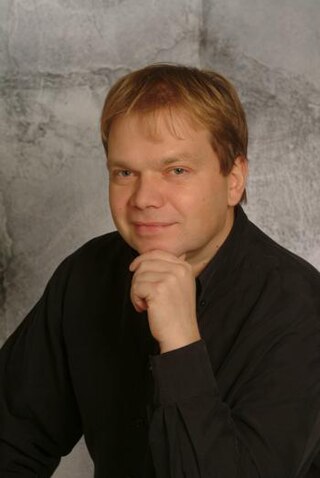
Andreas Boltz is a German church musician and composer. From autumn 1993 until 2011, he was the Regional Cantor of the diocese of Mainz in Darmstadt. He was awarded the Premio Speciale in 1992 at the International Composers Competition in Trieste. Since June 2011, he has been cathedral music director at the Frankfurt Cathedral.
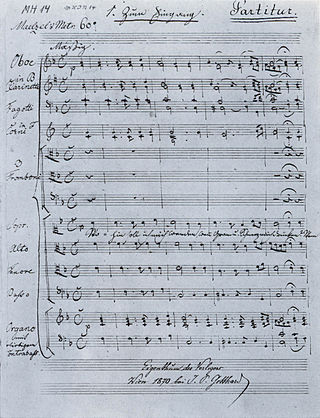
The Deutsche Messe, D 872, is a hymn-cycle by Franz Schubert written in 1827. Neither a Mass nor strictly speaking German, it was published in Vienna as what it is: Gesänge zur Feier des heiligen Opfers der Messe. It sets a sequence of eight non-liturgical German poems by Johann Philipp Neumann, who commissioned Schubert's music, one or more of which could be used separately during Mass. A ninth hymn, given as an appendix, treats the Lord's Prayer, bringing the length to about 35 minutes when the music is performed, as it often now is, as one big concert work.

Thomas Gabriel is a German church musician, composer and arranger.

Deutsches Hochamt is the title common to several mass compositions by Michael Haydn, setting the mass ordinary in German by Franz Seraph von Kohlbrenner. Three of the works require trained singers and orchestra, while a fourth is kept simple to be sung by the congregation as a Deutsche Singmesse (Betsingmesse). His best-known German High Mass is catalogued as MH 560. Haydn's masses in German are also known by the incipit of the first of ten songs, "Hier liegt vor deiner Majestät".

Lord, have mercy upon us, WoO. 12, MWV B 27, is the incipit of a motet for choir a cappella in both English and German composed by Felix Mendelssohn in 1833. It is also known in English as Responses to the Commandments, and in German as Zum Abendsegen. It was published in 1842, both in English and German, and by Breitkopf & Härtel in 1875 in the complete edition of the composer's works.
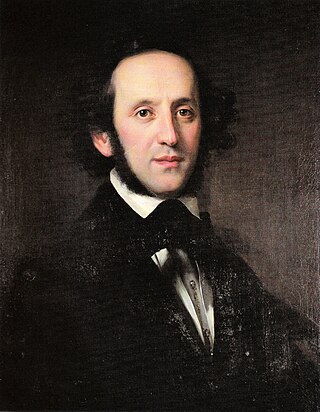
Denn er hat seinen Engeln befohlen, MWV B 53, is the incipit of a motet for an eight-part choir a cappella by Felix Mendelssohn. He wrote it in 1844 for the Berlin Cathedral, setting verses 11 and 12 from Psalm 91. Later, Mendelssohn made the motet with accompaniment part of his oratorio Elijah. It was published in 1844, and by Breitkopf & Härtel in 1875 in the complete edition of the composer's works.
Ehre sei dir, Gott, gesungen, BWV 248V, is a church cantata for the second Sunday after Christmas, which Johann Sebastian Bach composed as the fifth part of his Christmas Oratorio, written for the Christmas season of 1734–35 in Leipzig. The Christmas cantata was first performed on 2 January 1735. Bach was then Thomaskantor, responsible for music at four churches in Leipzig, a position he had assumed in 1723.

Wer bis an das Ende beharrt, is a motet for a four-part choir by Felix Mendelssohn. He wrote it as part of his oratorio Elijah, published in 1847.
Salmo 150 is a psalm setting by Ernani Aguiar. He wrote the composition, setting Psalm 150 in Latin for unaccompanied choir, in 1975. The short work was published by Earthsongs in the U.S. in 1993, and achieved international popularity.

Wie lieblich sind deine Wohnungen is a sacred motet for four voices that Johann Hermann Schein, Thomaskantor in Leipzig, composed in 1628, setting verses 2–4 of Psalm 84 in German.
Deutsche Messe is a Lutheran mass in C minor by Gottfried Heinrich Stölzel. He set the text of Kyrie and Gloria in German in 1739.

Vom Himmel hoch, MWV A 10, is a Christmas cantata by Felix Mendelssohn. He composed the chorale cantata, based on Luther's hymn "Vom Himmel hoch, da komm ich her", in 1831, setting selected stanzas with unchanged lyrics for soprano and baritone soloists, a five-part mixed choir (SSATB), and orchestra. The cantata was first published by Carus-Verlag in 1983, with an English version From heav'n on high.
